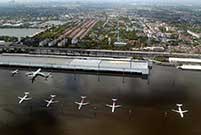

WUHAN, Dec. 21 -- After working in Shanghai for seven years, welder Wang Ting got a job offer from the inland city of Wuhan. He did not think twice before accepting, not only did it mean he could return to his hometown but the area has emerged as an economically promising region with plenty of opportunities.
"Export companies in Shanghai have been struggling, and salaries in Wuhan have caught up," said the 35-year-old from Hubei Province. "It's easy to find a job there and it's close to my hometown, so why not?"
For decades, the eastern metropolis of Shanghai on the Yangtze River Delta has abounded with high-paying jobs that made it a magnet for workers from upstream cities like Wuhan. The situation is now being reversed.
As rising costs and waning exports dragged down economic growth in coastal China, inland provinces along China's longest river, the Yangtze, have emerged as rising stars thanks to the convenient water routes, lower costs and booming markets.
Take GDP growth in the first three quarters for instance: the riverside municipality of Chongqing (11 percent) and provinces of Jiangxi (9.2 percent) and Hubei (8.8 percent) have overtaken their coastal peers Shanghai (6.8 percent) and Guangdong (7.9 percent), and now rank among the fastest-growing parts of China. They also stood out as other inland regions, such as northeast and north China, struggle with industrial restructuring.
Both workers and investment are following the river upstream from the coastal regions. Wang's new employer, an auto parts factory, is a supplier to Shanghai General Motors.
Despite the slowing car sales in China, the Sino-U.S. joint venture invested 110 million U.S. dollars into its fourth China factory, in Wuhan, which is capable of producing 240,000 cars a year. Another injection of 120 million dollars will double its capacity by 2017.
"The company's strategy is clear: China's coastal market are saturated, so it is eyeing the huge, untapped market in central and western China," said car industry analyst Jia Xinguang.
"It is moving production there, and the best location is the middle reach of the Yangtze, which boasts good transportation links, low costs and proximity to the central and western markets," he told Xinhua.
This strategy is similar to the approach of Beijing Hyundai, a joint venture between Beijing Automotive Group and the Republic of Korea's Hyundai Motor Co., which is building a new factory in Chongqing, a sprawling city in the upper reaches of the Yangtze that aims to become "China's Detroit".
EASY FLOW
Many inland provinces along the Yangtze are under the "Yangtze River Economic Belt," an area earmarked as a new economic powerhouse with the potential to offset the current downturn.
Covering 11 provinces and municipalities, the belt has a mature transportation network centering around the Yangtze.
Compared with railways and air transportation, water transportation can support higher volumes at a fraction of the cost. However, the waterway's potential is hindered by poor infrastructure, said Tang Guanjun from the Ministry of Transport.
In response, the central government has prioritized waterway and port upgrading. The river's Jingzhou and Luzhou sections are being deepened to accommodate larger ships, and a number of ports and highways are being constructed along the 6,300-km waterway.
Many companies are already moving to the region to benefit from the infrastructure boom.
Ezhou City, located on the southern bank of the Yangtze in Hubei, has seen warehouses spring up as courier companies and online shopping platforms relocate there.
SF Express, a leading courier in China, is building an airport complete with a logistic center in Ezhou's Yanji Township.
"We picked Ezhou for its convenient water, road and railway connections and the bright prospects of the Yangtze River Economic Belt," said Liu Zhiming, a managing director with SF Express.
A RIVER INTO FUTURE
On the national level, the waterway, which links the wealthy and industrialized delta and the less-developed inland, has been highlighted for buoying the economy and supporting development.
The belt allows industries, capital and technology in the Yangtze River Delta to move more easily to central and western China, thus, boosting development in the inland regions, said Hou Yongzhi with the Development Research Center of the State Council.
Qin Zunwen, vice dean of Hubei's Academy of Social Sciences, lauded the belt for connecting the coast with the inland, and contributing to the country's plan for an overall economic rejuvenation.
"Second only to the coastal economic belt, the Yangtze belt will likely become a key pillar of the Chinese economy," Qin said.
 Are these the world’s scariest landing strips?
Are these the world’s scariest landing strips? In pics: Left behind children in China
In pics: Left behind children in China Eight modern day engineering marvels of China
Eight modern day engineering marvels of China Chinese beauty with sexiest bottom
Chinese beauty with sexiest bottom Charming female bodybuilders of Chengdu University
Charming female bodybuilders of Chengdu University Polish sports stars strip off for risqué calendar
Polish sports stars strip off for risqué calendar Spectacular aerial photos of the Three Gorges
Spectacular aerial photos of the Three Gorges Contestants of Mrs. Globe pose for photo in Shenzhen
Contestants of Mrs. Globe pose for photo in Shenzhen
 Bikini models attend hot pot banquet in Hefei
Bikini models attend hot pot banquet in Hefei Top 20 hottest women in the world in 2014
Top 20 hottest women in the world in 2014 Top 10 hardest languages to learn
Top 10 hardest languages to learn 10 Chinese female stars with most beautiful faces
10 Chinese female stars with most beautiful faces China’s Top 10 Unique Bridges, Highways and Roads
China’s Top 10 Unique Bridges, Highways and Roads Reincarnation rip-off
Reincarnation rip-off Share a cab, share a bed
Share a cab, share a bed A shivery season for start-ups
A shivery season for start-ups 2015 Finding Humanity in Tragedy
2015 Finding Humanity in TragedyDay|Week